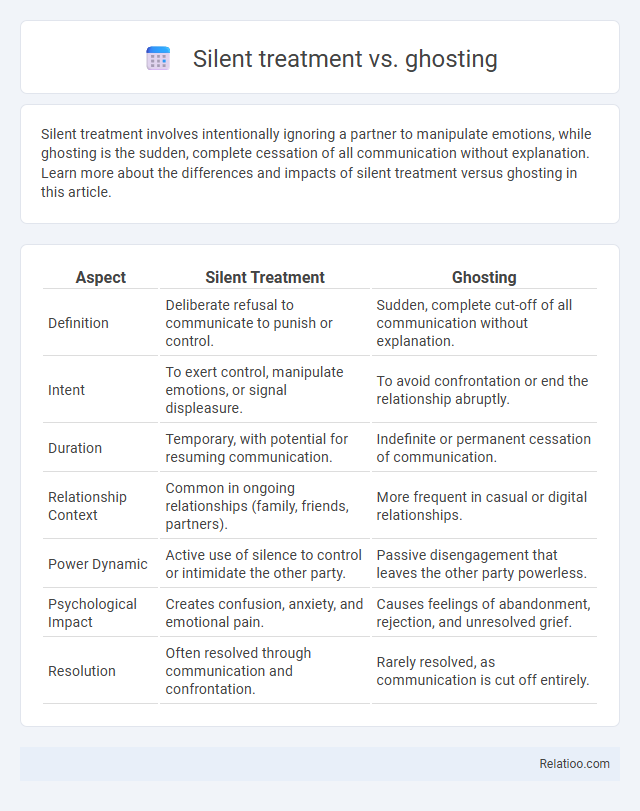Silent treatment involves intentionally ignoring a partner to manipulate emotions, while ghosting is the sudden, complete cessation of all communication without explanation. Learn more about the differences and impacts of silent treatment versus ghosting in this article.
Table of Comparison
| Aspect | Silent Treatment | Ghosting |
|---|---|---|
| Definition | Deliberate refusal to communicate to punish or control. | Sudden, complete cut-off of all communication without explanation. |
| Intent | To exert control, manipulate emotions, or signal displeasure. | To avoid confrontation or end the relationship abruptly. |
| Duration | Temporary, with potential for resuming communication. | Indefinite or permanent cessation of communication. |
| Relationship Context | Common in ongoing relationships (family, friends, partners). | More frequent in casual or digital relationships. |
| Power Dynamic | Active use of silence to control or intimidate the other party. | Passive disengagement that leaves the other party powerless. |
| Psychological Impact | Creates confusion, anxiety, and emotional pain. | Causes feelings of abandonment, rejection, and unresolved grief. |
| Resolution | Often resolved through communication and confrontation. | Rarely resolved, as communication is cut off entirely. |
Understanding Silent Treatment and Ghosting
Silent treatment involves intentionally ignoring or refusing to communicate with someone to express displeasure or punish, often occurring in close relationships. Ghosting refers to abruptly cutting off all communication without explanation, typically in dating or social contexts, leaving the other party confused and seeking closure. Understanding these behaviors is essential for recognizing emotional manipulation and fostering healthier communication patterns.
Key Differences Between Silent Treatment and Ghosting
Silent treatment involves deliberately ignoring someone while maintaining physical or social proximity, often used as a form of emotional manipulation within ongoing relationships. Ghosting refers to abruptly cutting off all communication without explanation, typically in dating or casual interactions, resulting in complete disappearance from the other person's life. The key difference lies in intent and context: silent treatment is a passive-aggressive tactic during continued engagement, whereas ghosting is an avoidance strategy marked by total withdrawal and absence.
Psychological Impact on the Recipient
Silent treatment often triggers feelings of confusion, rejection, and lowered self-esteem in the recipient, heightening anxiety and emotional distress due to the deliberate withholding of communication. Ghosting, characterized by sudden and complete communication cessation without explanation, can cause profound uncertainty, abandonment, and prolonged grief as the recipient grapples with unresolved emotions and lack of closure. Both behaviors can lead to significant psychological harm, including symptoms of depression, trauma, and trust issues, severely impacting the recipient's mental health and future relationship dynamics.
Common Reasons People Use Silent Treatment
Common reasons people use silent treatment include expressing anger, seeking control, or avoiding confrontation during conflicts. Emotional withdrawal serves as a defense mechanism to communicate dissatisfaction without direct communication. This behavior often stems from feelings of hurt, frustration, or the need to assert boundaries without engaging in dialogue.
Why Individuals Choose to Ghost
Individuals choose to ghost as a way to avoid uncomfortable confrontations and emotional discomfort. Ghosting allows a person to abruptly cut off communication without explanations, often seen in both casual and intimate relationships. This behavior contrasts with the silent treatment, which involves purposeful withdrawal to express displeasure or manipulate, whereas ghosting is typically a unilateral, definitive exit.
Communication Patterns: Silence vs. Disappearance
Silent treatment involves intentional silence within an ongoing relationship, aiming to communicate displeasure without direct confrontation. Ghosting refers to the abrupt and complete disappearance of all contact, ending communication without explanation or warning. Your understanding of these communication patterns can help recognize whether silence is a passive-aggressive tactic or a sign of final disengagement.
Signs You’re Experiencing Silent Treatment
Silent treatment often involves deliberate and prolonged refusal to communicate aimed at punishing or controlling, while ghosting abruptly ends all communication without explanation, leaving you confused and searching for closure. Signs you're experiencing silent treatment include consistent ignoring of messages, avoidance of eye contact, and emotionally cold or dismissive behavior despite your repeated attempts to engage. Recognizing these signs is crucial for addressing emotional manipulation and preserving your mental well-being.
How to Recognize You’re Being Ghosted
Recognizing you're being ghosted involves noticing a sudden and complete cessation of all communication without explanation, differing from the silent treatment which typically stems from conflict and is often temporary. Ghosting means your messages and calls go unanswered as the other person disappears abruptly, while the silent treatment usually involves a known pattern of withholding communication to express displeasure. Pay attention if your attempts to reach out are consistently ignored and there's no acknowledgment or reason given, signaling you're likely being ghosted.
Healthy Alternatives to Silence or Ghosting
Silent treatment and ghosting both involve intentional withdrawal of communication but differ in context; silent treatment is prolonged refusal to speak often within ongoing relationships, while ghosting abruptly ends contact without explanation. Healthy alternatives to silence or ghosting encourage open, respectful communication where feelings are expressed directly and boundaries are set clearly to foster understanding and resolution. You can foster trust and emotional well-being by addressing conflicts transparently rather than resorting to avoidance tactics.
Rebuilding Trust After Silent Treatment or Ghosting
Rebuilding trust after silent treatment or ghosting requires consistent communication and genuine effort to address underlying issues. You must prioritize transparency, express feelings honestly, and set clear boundaries to restore emotional security. Establishing accountability and demonstrating reliability through actions helps repair relationships damaged by these harmful behaviors.

Infographic: Silent treatment vs Ghosting
 relatioo.com
relatioo.com